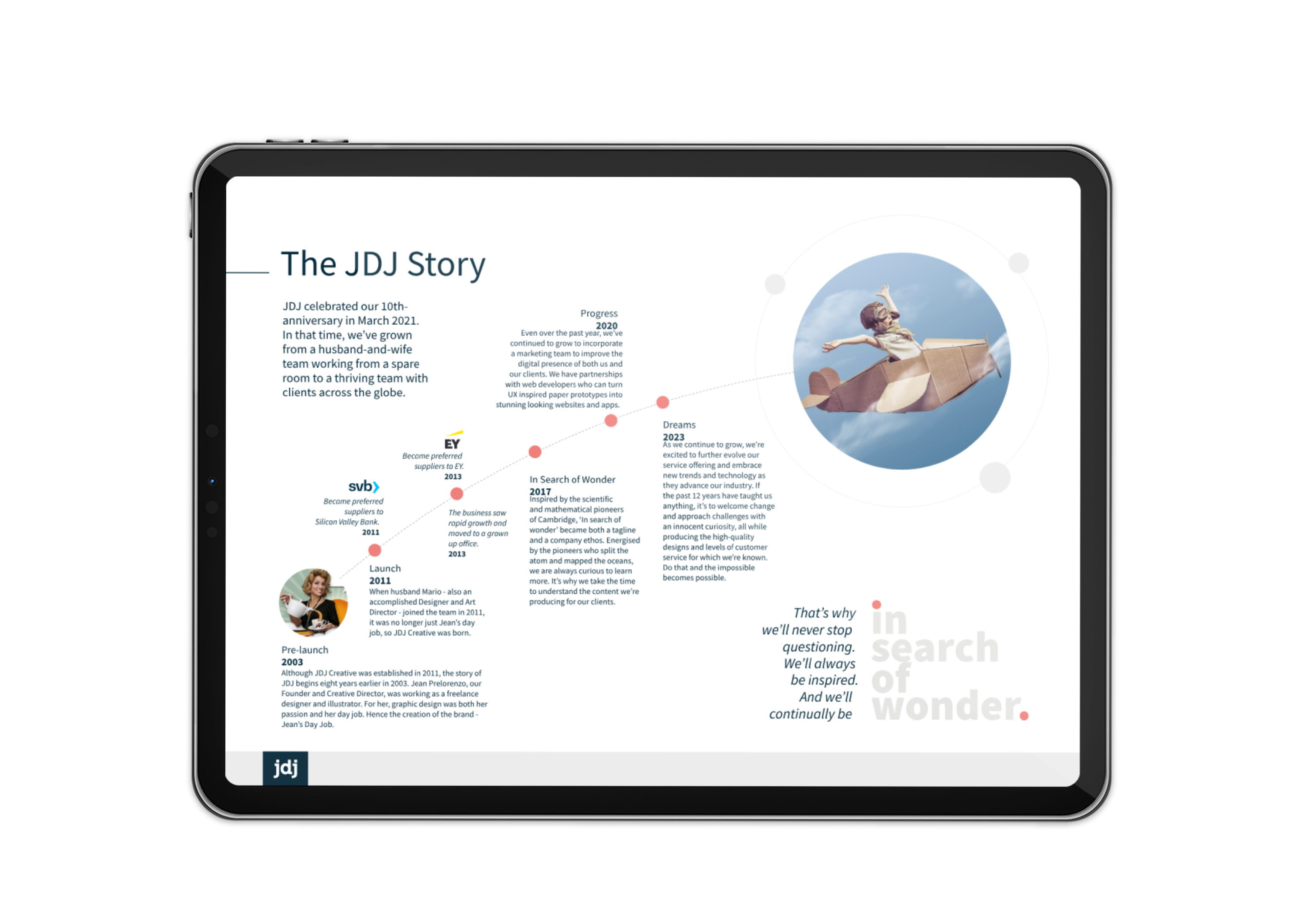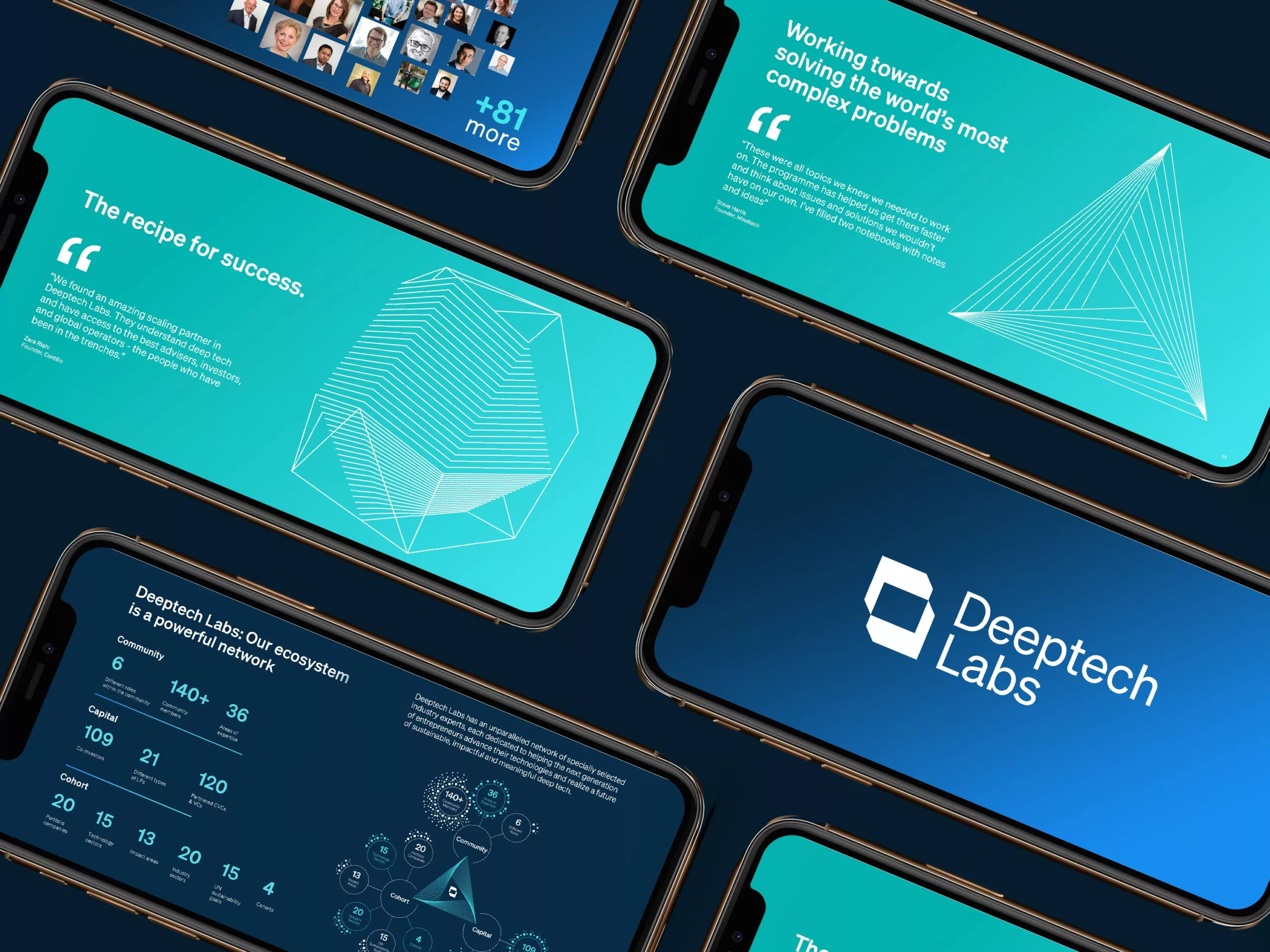While you could have the greatest idea in the world, as an entrepreneur you know that a business is nothing without investment. That’s why a pitch deck is so important. It’s a document that sells your idea and your vision for your start-up company. One that gets people interested and encourages them to be a part of your journey.
Similarly, an investor presentation deck will help persuade potential investors to support your venture financially. Without a compelling story, proof of your product’s effectiveness and a convincing business plan, you’ll struggle to get your business off the ground.
But to really impress potential stakeholders, a well-designed slide deck is essential to showcase your brand, professionalism, messaging and value proposition. In this blog, we will look at ways in which you can build trust and credibility with your audience through powerful design and why it’s important.
Investors see a lot of decks. That means yours needs to stand out. Research by the secure document-sharing platform, DocSend, has found that the average time spent by VCs analysing pitch decks is now routinely just two-and-a-half minutes or fewer.
To maximise your chances of getting funding, you need to make sure that your pitch deck is well-designed and visually appealing. And it needs to attract attention from the very first glance.
The easiest way to convey professionalism is to have a uniform look across all your collateral. That means using consistent colour schemes, typographic choices and imagery at a minimum. Spending time to perfect these brand identity basics is essential when looking to present yourself as a worthwhile investment. You should then roll this brand image out across your deck, website, social media and all other marketing materials a potential investor could find.
Besides this basic requirement, another way to make a good first impression is through your cover slide. Having a strong first slide will set you off on the right footing, so make it count. The type of imagery you use should come out of discussions with your branding agency.
Tips for a strong opening slide:
Likewise, it’s important to end your pitch strongly with an impactful final slide.
Remember, this slide will stay on screen after the presentation part has ended and the Q&A segment has begun.
There are many great ways to make a memorable final impression.
You could use this last slide to summarise the key points of the pitch – the information you want investors to take away with them. Or reemphasise the potential opportunity. Signing off with a simple logo and call to action could reinforce your brand image, while a team photo could represent the expertise that will make you a success. Just don’t ruin a great pitch deck by ending with a slide that just says ‘Questions?’, or worse, one that lists any weaknesses.

In creating a brand, you should already have thought about your purpose and vision – the ‘why’ behind your company’s reason for existing. The exploration of this theme by your branding agency will have influenced the design options they provided for your logo, the colour choices they proposed, and the imagery they suggested you use.
Discovering whether traditional values guide you, or a desire to change the world, will have determined whether they feel a serif or sans serif font is more appropriate for you. Maybe green tones represent your environmental ideals, or pink the desire to appear rebellious.
These design elements will already do some of the heavy lifting for you, subconsciously painting a picture of your company in the audience’s minds.
Now it’s time to spell it out explicitly. To use that purpose to create your brand story.
Investors want to feel part of your journey, so give them an emotional connection throughout your deck.
This hook will often be through your ‘the problem’ slide.
By ensuring the problem your company is solving is relatable to your audience, highlighting your solution, and sharing a future vision – one where your offering has made a real difference – you can engage investors on a personal level.
By playing on this connection throughout the deck through a logical narrative, you can increase your chances of success.
Alongside this, images, infographics and charts can quickly communicate key information, without detracting from the overall narrative. Visuals can be a powerful way to reinforce your brand story and values.

“
– Mario Prelorenzo, Managing Director

Having interested your audience with a great first impression and further intrigued them through your storytelling, it’s time to focus on the nitty-gritty. The financials and data can make or break a pitch.
Whether showing the size of the market or 5-year revenue projections, charts and infographics should figure heavily on your pitch decks.
To ensure they complement rather than detract from your narrative, it’s important to follow these rules:
What makes a good pitch deck? To leverage design’s power in investor presentations, here are some best practices to consider:
Investors are looking not only at your business idea but also at your team’s capability to execute it. Design choices reflect the level of professionalism and attention to detail you bring to the table. As we keep reinforcing, a polished and well-structured presentation shows that you’ve put thought and effort into your pitch.
Consider this: if you neglect the design aspect of your presentation, investors might wonder if you’ll also cut corners in your business operations. On the other hand, a carefully crafted presentation communicates dedication and seriousness about your venture.
Every investor group has its preferences and expectations. Design should be tailored to match these preferences. For instance, venture capitalists might appreciate a clean and data-driven design, while angel investors might respond well to a design that highlights the human side of your business.
Understanding your audience allows you to make design choices that resonate with them, fostering a deeper connection.
Are you ready to elevate your investor presentations with impactful design? We’ve partnered with global businesses in the financial sector for over a decade. To learn how our expertise can help you craft presentations that captivate and persuade, contact JDJ Creative today at hello@jdjcreative.co.uk or fill in our contact form.
Share
Sign up to our monthly newsletter to receive your guide to thought leadership design.

Sign up to our monthly newsletter to receive your guide to annual report design.

Sign up to our monthly newsletter to receive your guide to sustainability report design.
